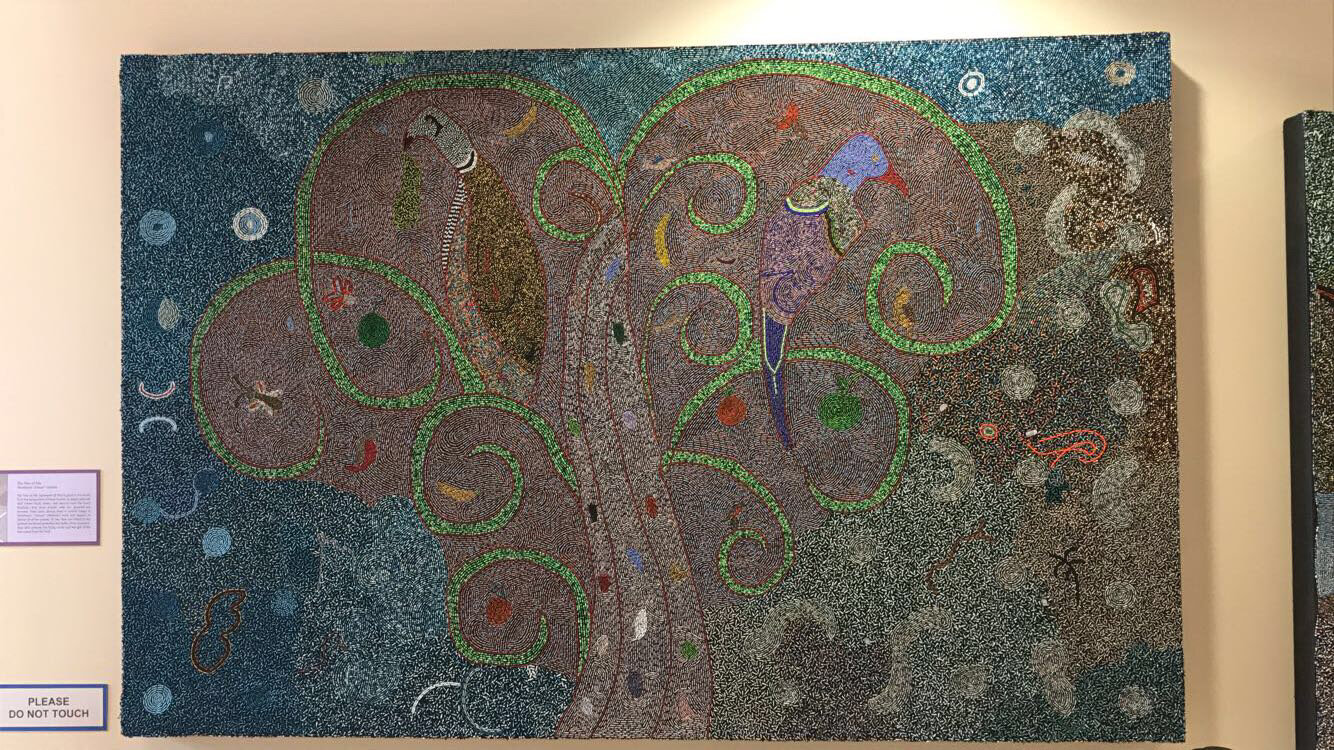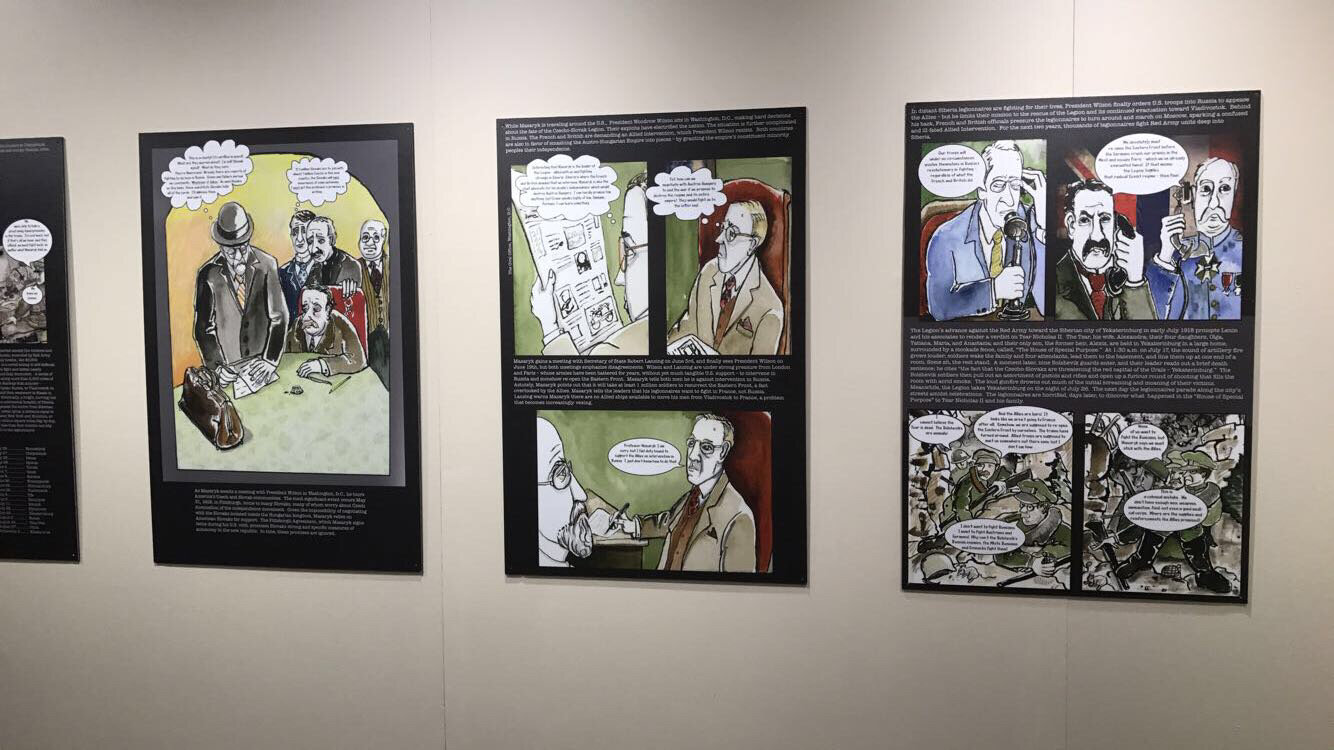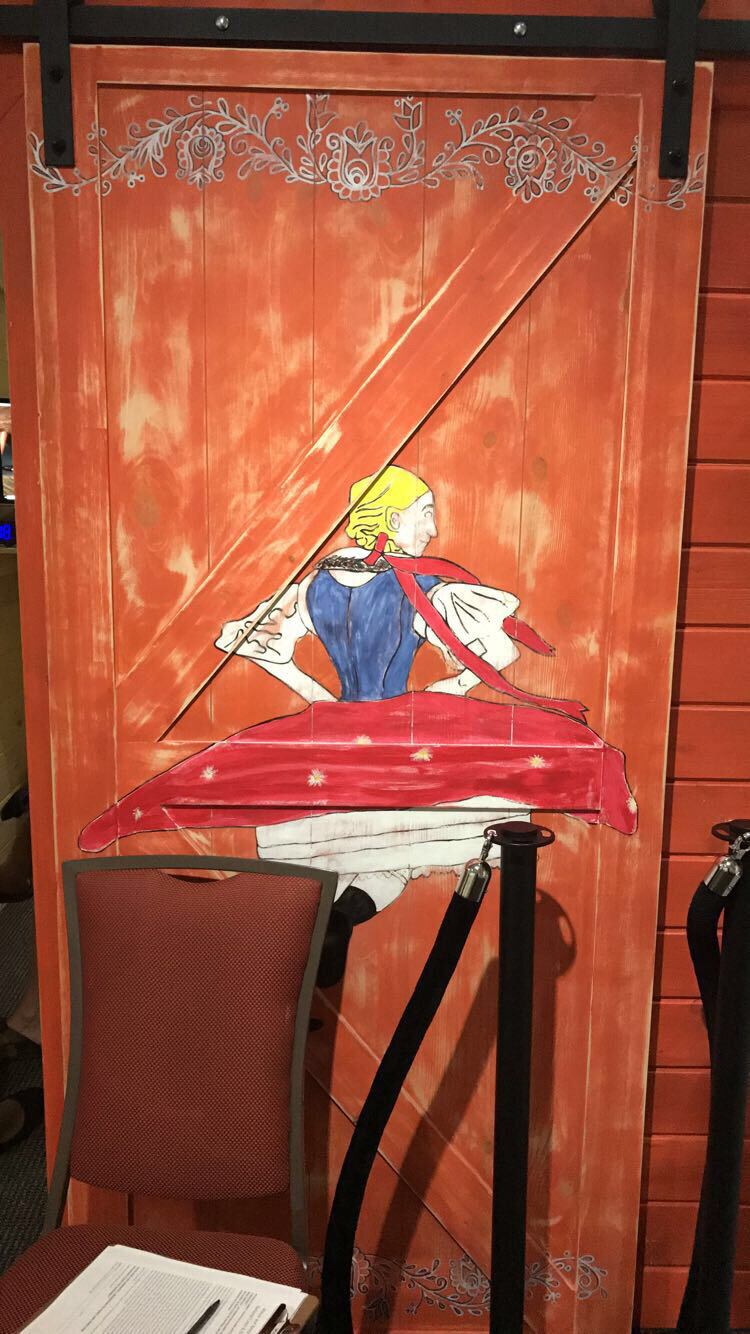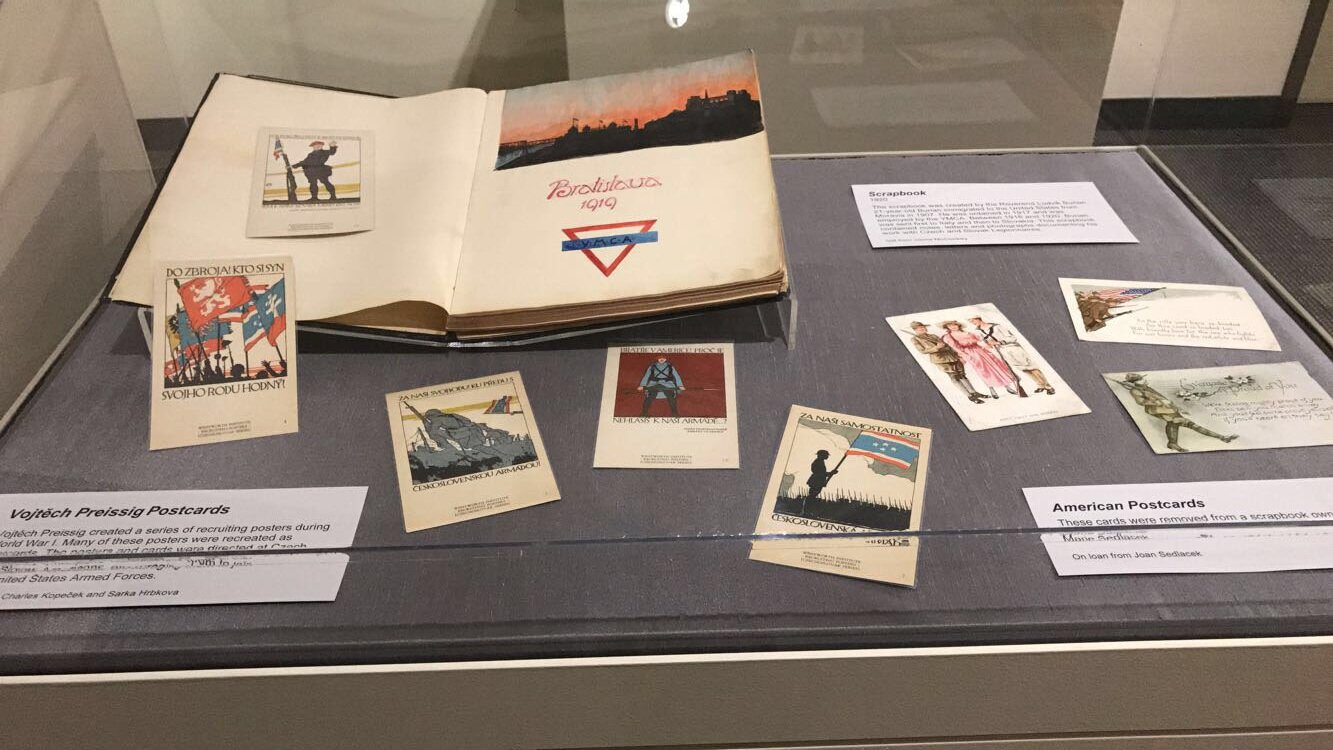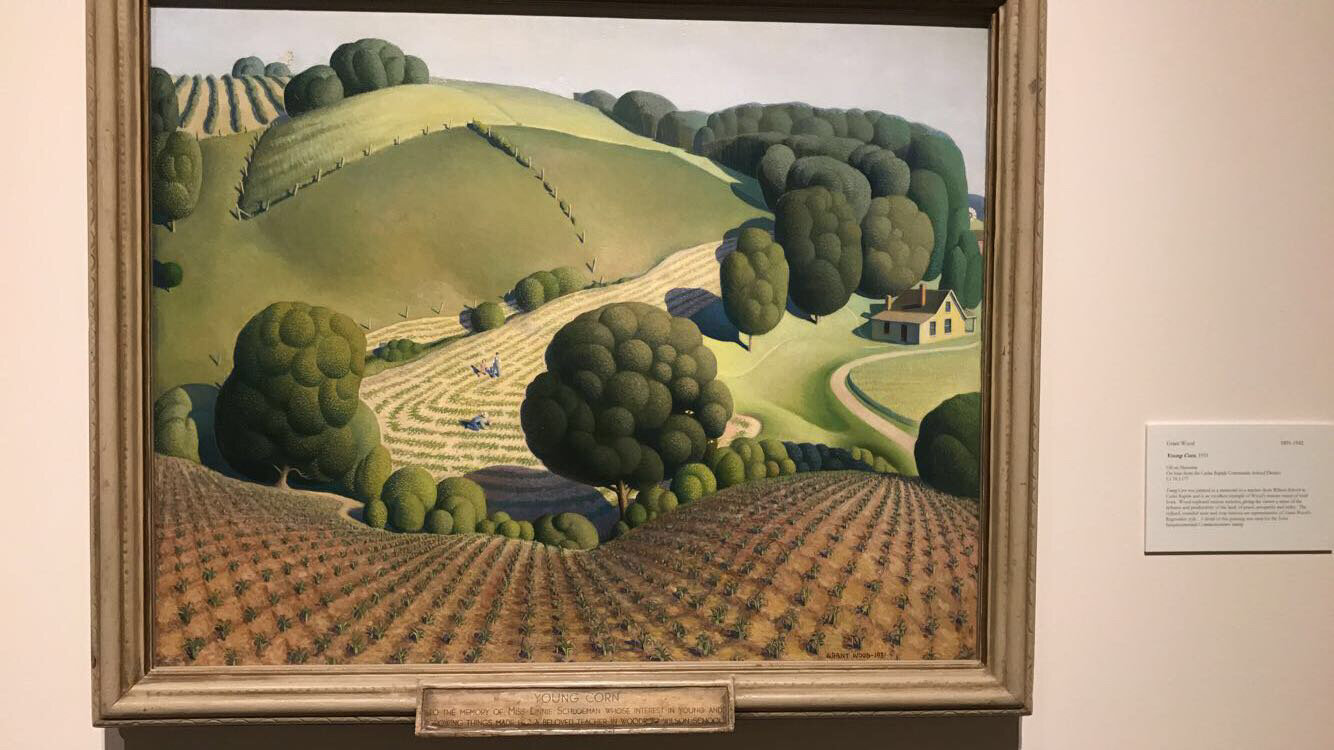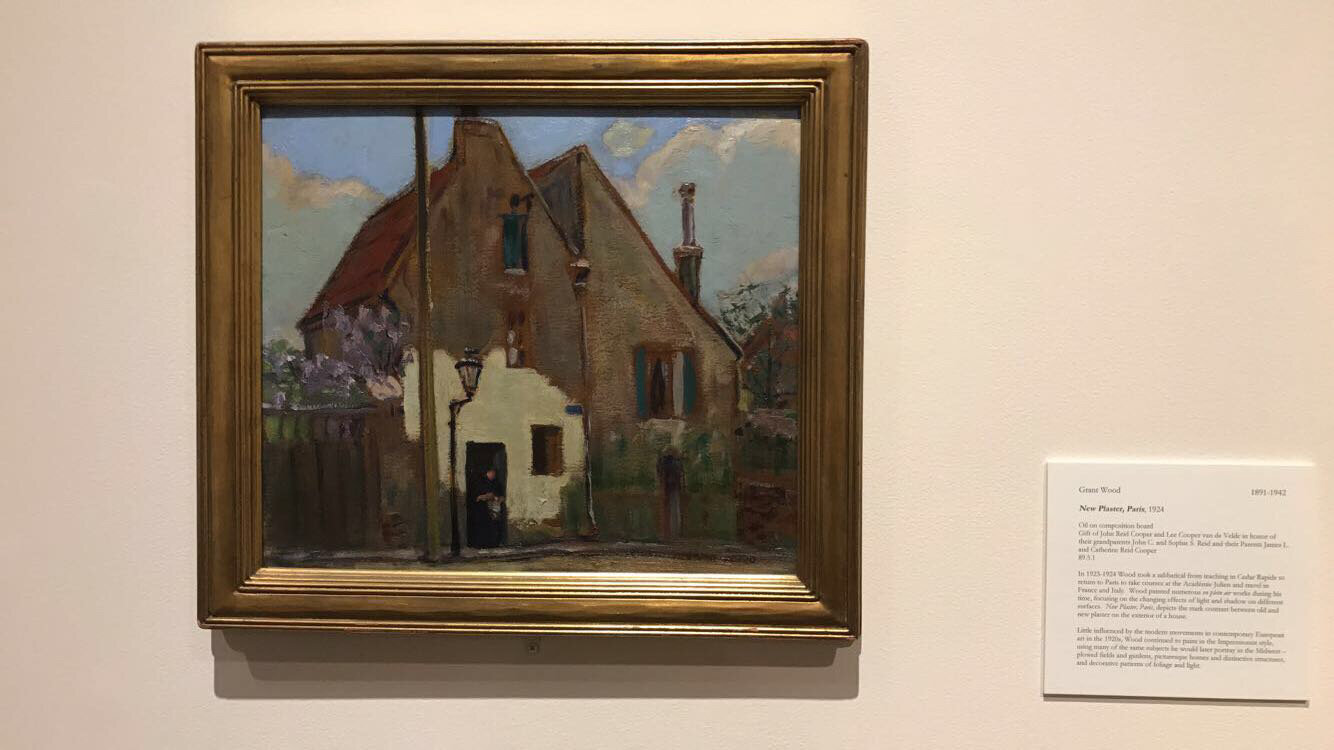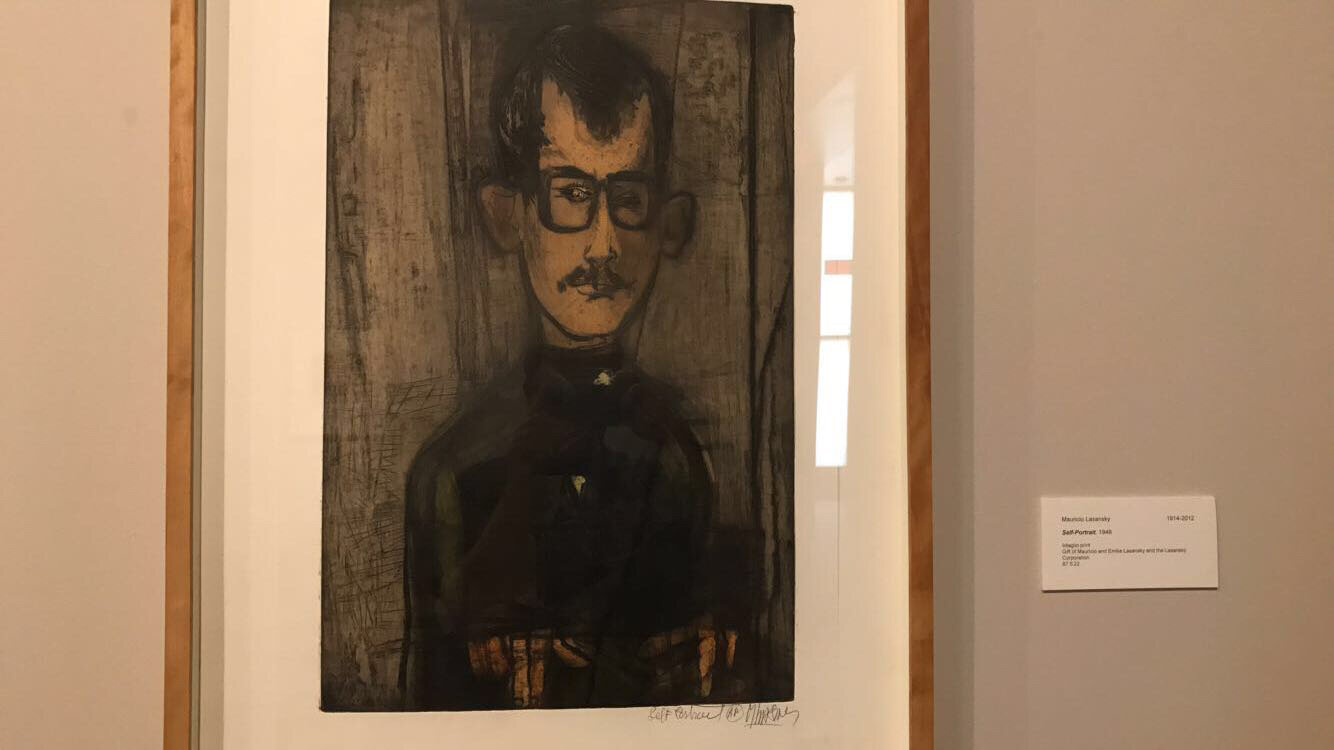IA Day 2 - Portraits, Pizza, and Pieces of Czech History
My second morning in Cedar Rapids began with a little dive into the city’s Czech heritage. I drove down to the New Bohemia District for some coffee at the excellently named Brewhemia. The coffee was good and strong, and their aesthetic was a fun blend of homey and artsy which gave it a great hang-out vibe.
After fueling up, I made my way to the city’s National Czech and Slovak Museum and Library which was really stunning right off the bat with its neat geometric brick architecture that makes it look almost look like a small Eastern European village seen from the distance:
When I walked into the museum, the lobby really established an early wow factor with a dazzlingly ornate glass chandelier hanging from the ceiling and a wild carved wooden crucifix decorated in traditional Czech beads hanging from the walls.
Once I got through the lobby, my first stop within the museum was a small cottage just outside the main building that had been built in 1890 by the Sleger family, Czech immigrants who traveled from Bohemia to Iowa, and moved to this current location in 1983.
In an effort to recreate the early Czech Immigrant experience with carefully curated artifacts and furnishings from around 1880-1890. I have no idea which if any artifacts were actually original to the family who built the house, but the attention to detail made everything feel of a piece with one another to create a real sense of hominess. The thing that really stood out to me the most was how beautifully hand-crafted all the wood- furniture was.
My favorite pieces with in the house were a series of adorable little corn-husk doll which felt like a sweet way of using the natural resources of Iowa to recreate a little bit of home for the kiddos, and a vintage accordion gently nestled on a fine cloth covered couch.
As a nice bonus, outside the immigrant home was a sweet little view out over the Cedar River:
Back inside, the hallway had some more absolutely astonishing examples of artwork made from colorful Czech glass beads. I read that the pieces were a style of bead art called ndwango sewn by a community of female artists from South Africa called the Ubuhle Women, and there was a whole traveling exhibit of ndwango art further along in the museum which I was now really looking forward to seeing it.
Next up in the hallway was a display case filled with really beautiful Czech clothing adorned with more colorful beadwork:
The first major exhibit I checked out inside the Museum was entitled Guts and Glory, and it was dedicated to the absolutely insane story of the Czechoslovak Legion during WWI. The Legion was a battalion of ethnically Czech and Slovak soldiers living in Russia who had banded together fight against Austria-Hungary in the war. The Russian Empire had initially tried to prevent the legion from growing too big lest military success were to lead to the Czechs and Slovaks feeling like maybe they wanted more independence, but their military track record (including singlehandedly defeating Austrian troops in the Battle of Zborov) eventually led to the Russians begrudgingly giving them more autonomy. After the Bolshevik’s seized power during the Russian Revolution, the head of the National Czechslovak Council, Tomáš Masaryk, traveled to begin negotiations for the Legion to leave Russia and travel to France to continue Austro-Hungarian forces there. The Bolsheviks agreed and the Legion began to set out from Ukraine back to Western Europe in 1918 only to immediately be caught up in a major German push to take control of the Eastern front. The Legion successfully fought off German forces in a series of intense battles and made it out of Ukraine. Once they were back in Russia proper, a condition for their safe passage out of Russia was that they surrender the majority of their weapons as the Bolsheviks were wary of trusting the Legion too much for fear that their loyalty may have been more to the old Russian Empire. The Legion complied and began riding the Trans-Siberian Railway out of Russia. While stopped in Chelyabinsk, the train carrying the Legion encountered a train carrying Hungarian POWs who considered the Legion to be traitors (modern day Czech Republic and Slovakia were under control of the Austro-Hungarian Empire) and a fight broke out. The Legion defeated the loyalists, but the Bolsheviks considered this a breach of their pact and tried to arrest Legion soldiers who fought off the Hungarians. The Legion felt this was unjust since they had only been defending themselves, and they turned on the Bolsheviks and freed their imprisoned comrades. When new of this revolt reached Trotsky, he withdrew all support of the Legion and ordered their arrests. At this point, the already dramatic story just takes on an almost folkloric quality, because, in order to ensure their freedom and still hoping to reach Western Europe as they intended, the Legion seized control of the Trans-Siberian Railroad. This cut off Bolshevik rail access to Siberia and served to inspire Anti-Bolshevik forces throughout the region. The Legion had never intended to get involved in the Russian Revolution, but they unwittingly became sort of anti-Bolshevik bandits traveling from town to town throughout Siberia successfully overthrowing Bolsheviks wherever they landed. They held the railway for nearly two years, and even managed to capture the Imperial Gold Reserve! This made them heroes abroad and a considerable problem for the growing Red Army, but the soldiers really just wanted to go home to Czechoslovakia, which had only just been named a sovereign nation at the end of WWI. US and Japanese Allied forces helped some of the Legion escape, but progress was slow and after two years of increasingly difficult battles the Legion leadership decided to make a controversial deal to hand over White Russian admiral Aleksandr Kolchak, whom they were supposed to be escorting to allied forces, to the Bolsheviks. The Bolsheviks executed Kolchak but allowed the remaining Legion soldiers to leave the country.
The whole wild saga unfolded throughout exhibit through text by author Kevin J. McNamara and illustrations by graphic novelist Rachel Marie-Crane Williams which really brought all the human drama and difficult decisions by key players to the fore.
The Legion’s story was accompanied by actual artifacts, uniforms, and weaponry from their time on the Trans-Siberian Railway, and in a neat bit of curation the museum had organized the displays to look like they were in giant train carts which also helped drive home how crazy it was that Legion troops had to live and fight out of those train cars for so long.
My personal favorite artifacts were postcards and posters from the War because they combined the intense hyperbolic imagery of military propaganda with the sleek minimalism of art deco to really striking effect.
After the exhibit about the Legion, the next gallery was dedicated to more incredible bead art by the Ubuhle Women art collective from South Africa. The beads were all imported from Czech craftsmen, but what the female artists did with them was nothing short of magical. Inspired by Xhosa textile art, the ndwango bead art of the Ubuhle has been described as “painting in bead” for the way they are able to create both colorful abstract and figurative scenes that seem to flow more like brushstrokes than mosaics.
Every work of art was really astounding but my personal favorite pieces were a dreamlike blend of abstract and realist forms. Highlights for me included: a vibrant orange scene by Zondlile Zando with a nostalgic representation of the artist’s childhood peach tree as a centerpiece; another piece by Zondlile Zando imagining a chalice and a floral centerpiece for a banquet for the gods; and a series of larger than life, almost celestial, beaded portraits of various bulls and cows by several artists in the collective (unfortunately my photos weren’t quite good enough for me to match the specific artist to each bull, but they’re all so talented so I’ll just list each of the featured artists: Zanele Muholi, Ntombephi “Induna” Ntobela, Zandile Ntobela, Thando Ntobela, and Nonhlakanipho Mndiyatha)
After the exhibit about the Ubuhle Women, I made my way to the museum’s main permanent exhibit which serves as a walk through Czech and Slovak history and cultural touchstones. This began with a cool intro gallery focused on bringing the human element to all the historical stories that would follow, through really beautifully realized life sized drawings of people representing Czechs and Slovaks from various pivotal points of time next to speakers where visitors can actually listen to real people’s stories. All around them are quotes from important figures around themes of freedom which and identity that serve as a through-line throughout the gallery.
After the intro, things began with some great early medieval art depicting the burning of Czech radical theologian Jan Hus at the stake (Hus is a hugely important figure in Czech history, but it definitely cracked me up a little that such a wild, dramatic scene is essentially one of the first things you see when you walk in) and a more scenic rendering the Battle of the White Mountain near modern-day Prague in which Bohemian Protestants were absolutely massacred by the Catholic armies of the Holy Roman Empire. Early Czech and Slovak history certainly doesn’t paint Catholicism in the most flattering of lights.
Jumping quite a ways forward in history, next up were some really incredible black and white photographs of Czech and Slovaks immigrants, refugees, citizens, and soldiers during the World Wars. It’s really heartbreaking to see so vividly how much Czechoslovakia was just starting to flourish before WWII brought Nazi invasion and approximately 300,000 casualties. The Czechs and Slovaks did not take Nazi occupation lying down, but despite several uprisings and attempts at revolution they were constantly vanquished until the end of the war.
At the center of the gallery, there was a big recreation of a brick clocktower floating above a (possibly authentic) city street post covered in Czech and Slovak posters that capture a youthful sense of art and vitality from the late 20th century.
One wall was filled with gorgeous art-deco posters and photographs from the “Golden Age” of the 1920s when Czechoslovakia was flourishing as the only democratic nation in Eastern Europe.
Next up was a model mid-century home that Czech and Slovak immigrants might have lived in once moving to the United States, complete with a vintage radio, old board games, and a collection of stylish jewelry:
Some of the framed art in the house did strike me as maybe a bit intense for the average suburban family like this piece featuring a Blacksmith nobly defending his home from invading soldiers:
Up next there was a pretty funky looking car called the Tatra, which looked a bit like a sleeker Popemobile. Tatra no longer produces passenger cars, but they have the distinction of being the third oldest car manufacture in the world which makes them quite a cool bit of Czech history.
Next up were some displays about post-war life under Communist rule, which was a divisive and difficult time in Czechoslovakia where a growing number of revolutionary academics, artists, and public figures frequently and violently butted heads with an increasingly authoritarian regime. The photos from these times featuring either alarmingly homogenized state-approved demonstrations or tumultuous protests paint a very dystopian picture of a nation at odds with itself.
Czech writer Milan Kundera, who wrote the excellent novel The Unbearable Lightness of Being, describes life under Communism rule much better than I could so I’ll let the large quote they put above these photos speak for itself:
The next displays were some of my favorites capturing the voracious appetite for all things pop culture by Czech and Slovak youth in the 60s and 70s. Highlights for me included: giant Smurfs posters; Bugs Bunny bubble gum which was popular purely because of its perceived American-ness; records by Czech icon Marta Kubisoca whose ballad Modlitba pro Martu was deemed too rousing by the Soviet Union and censored as much as a hit song can be; and a pair of Levi jeans which were a hot commodity amongst the youth despite being banned for being “too Western” so kids would sometimes have to drive for miles to get some contraband demin.
Next up was a wall decorated with colorful posters for everything from protests to sporting events and even Yellow Submarine.
Walking to the next galleries, visitors pass under a recreation watchtower of the kind that used to surveil the Czechoslovakian border during the Cold War to prevent any escaping from Communist rule. Even knowing it was fake, there was something really ominous about the idea of the tower watching you.
After passing under the watchtower, I found myself boarding a model steamship of the type that would have carried many a Czech and Slovak immigrant to the United States before the Cold War. I really liked how the museum organized the sleeping quarters so it looked like someone had just started unpacking. Something about it really brought the scene to life.
The ship was also filled with displays of items immigrants would have brought with them to remind them of home and to start their new lives in the states. Highlights for me included: some really delicate porcelain; various items from early 20th century shops run by Czech and Slovak immigrants; a number of highly decorative prayer cards and holy books; and the story of Rosa Sonneschein, a Czech writer who immigrated to the United States in 1864 where she would go on to found the first ever magazine marketed at Jewish women in the states called American Jewess. I’d never heard of Rosa before, but the idea of a female, Jewish immigrant creating her own success in 19th century America is pretty incredible.
Next up was a display about Sokol, a Czech gymnastics organization that became sort of like a secular mix between the YMCA and the Boy Scouts, blending a philosophy of athletic, moral, and psychological training.
Next up a vintage Jawa motorcycle, a Czech brand that rose to worldwide popularity around the mid 20th century. It’s a funky looking bike, but I just got a kick out of it having the same name as the weird little aliens that capture R2D2 and C3PO at the beginning of the first Star Wards movie.
Up next was a puppet theater because apparently puppets have historically been a very popular form of entertainment for Czech and Slovak children. The theater had some small hand puppets that visitors could play with, and next to the theater there was a display of vintage marionettes that were both expertly hand-crafted and mildly horrifying.
Up next was a display celebrating Czech and Slovak artists, with an emphasis on 20th-century film and literature. Personally, I was only really familiar with Kafka, Milos Forman, and Milan Kundera, but honestly the three of them would be enough to have made a pretty indelible mark on contemporary arts and culture.
Next up were some displays of more traditional arts and crafts. Highlights for me included: an intricate carved wooden farm scene; some beautiful enameled Slovakian plates and bowls next to a crazy little pipe carved like two heads on top of each other; elaborately painted decorative Easter eggs; and some vividly embroidered vests that would certainly make you stand out in any room.
One of the most impressive pieces to me had to be this unreal portrait of the celebrated violin virtuoso Niccolo Paganini made in tinted glass by the artist Lukas Novotny.
Next up was one of the museum’s most celebrated exhibits, their collection of traditional Czech and Slovak folk costumes called Kroje. The museum’s collection is the largest in the world outside of Slovakia and the Czech Republic, and the oldest piece in their collection goes back all the way to the 16th century. Some style of Kroje were once worn as everyday clothes, but the intricate embroidered patterns and pleats aren’t exactly the most practical in our modern world so now they’re only worn during special feasts and festivals as a way of honoring that history.
Leaving this exhibit, I passed one more show-stopping piece of craftsmanship in the form of this insane 19th century Bohemian armoire. The wood carving is incredible, but I really loved the painting because the pattern has such an unusual depth to it that you get a little M.C. Escher vibe with your religious iconography.
After the permanent galleries, I visited the Skala Bartizal Library, the library portion of the National Czech and Slovak Museum and Library. The library contains a vast archive of materials pertaining to Czech and Slovak history and culture in a variety of formats ranging from books to academic journals to magazines and even a sizable collection of phonograph records. Naturally though my favorite thing I saw there was this adorable sculpture made out of books called The Librarian.
The art on the walls of the Library was pretty stellar as well with a mix of vintage posters and more contemporary pieces that really showed off traditional outfits in dynamic ways.
Lastly, before leaving I got one more look at some of them Ubuhle Women’s astonishing beadwork. I got a closer look at the really jaw-dropping piece called African Crucifixion which was a collaborative effort between artists Tshengi Duma, Sthembile Majola, Nontanga Manguthsane, Nonhlakanipho Mndiyatha, Kalipha Ntobela, Ntombephi Ntobela, and Thembani Ntobela, and I came across one more massive mural just sort of tucked away near the elevators that was an impressive blend of abstract and natural forms. I really didn’t know what to expect from this museum going in, but I really had a great time and got more than my money’s worth.
Walking back to my car, I strolled past this adorably tiny clocktower:
For lunch, I stopped at an Iowa-based fast food chain called Maid-Rite, which is home to the hilariously named “loose meat sandwich”. While the name is not exactly the most appetizing thing in the world, it’s actually like a happy medium between a hamburger and a sloppy Joe which made for a mighty fine comfort food lunch.
After this hearty loose meat lunch, I headed out for my next destination, taking a few stops to enjoy the public art around Cedar Rapids.
My next stop was the Cedar Rapids Museum of Art, which made a pretty striking first impression with some large-scale outdoor art. Highlights for me were Bruce Beasly’s sleek steel geometric sculpture called Rollic and Jun Kaneko’s massive brightly colored ceramic heads in a piece called Primary Vision.
Stepping inside, the museum’s lobby was playfully strange. With its sharply angled glass skylight and giant bright red columns designed modernist architect Charles Moore, you got the impression that you entering a space somewhere between a circus tent and more classically designed museum.
The first gallery I visited was dedicated to modern and contemporary works by Midwestern Artists. It was a great place to start showcasing a fun blend of contemporary strangeness with more traditional Americana to shake up any preconceived notions of “Midwestern Art” visitors might have. Highlights for me included: an Andrew Wyeth-y painting called The Barn by Grant William Thye; a mesmerizing triptych filled with surreal nature imagery by Rose Frantzen called the Dormancy Series; an incredible mixed-media assemblage of found and carved painted wood by Richard D. Pinney called “Where Have You Been It's Almost Dark”; a sweetly nostalgic painting called Amish Boy by Zora DuVall; a giant pop-art painting of buttered corn Corn Painting by an artist whose name I didn’t catch; an abstract landscape painting by Thomas Agran called Near Great Bend River Kansas; and a fascinatingly ethereal painting of an octopus called "Her Long Arms Could Reach Them All" by Bill Stamats.
Next up was a gallery dedicated to Cedar Rapids’ own Marvin Cone. Cone never achieved huge fame in his own right but he was close friends with Grant Wood and well respected by other contemporary American painters. I had never heard of him personally, but I really loved his artwork and the way he’d bring a sort of magical realism to the landscapes and scenes he painted. I’m glad the museum made a space to highlight such an astounding local talent, and it was really neat to see how his style evolved over the years as he experimented with impressionism, realism, surrealism, and even full abstraction.
My favorites of Cone’s pieces were these larger landscape paintings that used strange perspectives to imbue the great plains with an almost mythic sense of grandeur. The giant clouds in particular strike a balance between beautiful and ominous, really capturing how temperamental and powerful the natural world can be.
The next gallery was dedicated to the man who is probably Iowa’s most famous artist, Grant “American Gothic” Wood. The museum has a sizable collection of paintings and sculptures by Wood, and, similar to the Cone gallery, they’re really able to show the breadth of his talents and creativity. As great as American Gothic is, Wood was no one-trick pony, and it was cool to see just how versatile he could be. His pieces ranged from more impressionist scenes to ruggedly realistic farm scenes to the more strange and heightened expressionism typified in his most famous work.
My favorite pieces included: the richly atmospheric Overmantle Decoration; a barn scene that had a two-dimensional feel almost like a classical multi-paneled mural; and a strangely dynamic scene of a cluster of windswept autumn oaks.
Wood’s paintings were accompanied by some of his sculptural works that also seemed to strike a balance between the familiar and the surreal. My favorites included: some funky plants that look like they’re made out of children’s toys; an old door that used to belong to his studio; and a hilarious wooden bench with crying children’s faces on the ends and the slogan “The way of the transgressor is hard” carved into it, that Wood made for children to sit on while they were waiting in the principal’s office at the local elementary school.
The next gallery featured one of the museum’s special exhibitions, which was dedicated to different representations of birds in art. I always like when exhibits are organized around a more general theme like this, because you get to see how artists from different countries, time periods, and stylistic traditions tackle the same subject in their own unique ways.
My favorites of the birds included: a dramatic scene of Pinnated Grouses by possibly the most famous bird painter John Jacob Audubon; a dreamlike gauzy painting of birds, machinery, and plants by Ellen Lanyon; a striking woodblock print of a dodo bird called Phoenix Rising by John Buck; some funky little carvings of an owl and a chicken; a cute cartoony silkscreen silhouette print called Philosopher Aware of Bird-Leaves by Morton Garchik; a vibrantly colorful aquatint etching of birds on an ornamental rug called An Acre for a Bird to Choose by Katja Oxman; a street with a very portly pigeon called Below My Window by Marvin Cone; a sweet watercolor of young girls tending to their chickens by an artist whose name I didn’t get; two hyper-colorful portraits of extremely punk rock looking birds by Laurie Hogin; and some adorably minimalist ink prints of an owl and a pelican by another artist whose name I sadly didn’t catch.
The next special exhibition was called The Grand Tour: Europe Through Artists’ Eyes, and it collected pieces from a fruitful trip a young Marvin Cone and Grant Wood took together to travel and study art around as many major European cities. There’s a real youthful exuberance to the way these paintings capture two promising artists at the beginning of their careers as they excitedly devour all the sights, scenes, and artistic techniques they come in contact with.
Complementing the pieces by Wood and Cone were some really stunning prints and paintings by different European artists who they may have taken inspiration from during their travels. Some pieces were lighter and more impressionistic, but for the most part the various etchings and drawings captured a depth and realism that was truly extraordinary.
My favorite pieces of the various European artworks included: a fairy-tale-like German castle; a whimsical abstract street scene by Sharon Burns Knutson called Thinking of Prague and My Sisters and I Settling My Mom's Estate; an almost hallucinogenic color etching of a canal in Venice; and a gorgeously sun-dappled water color of a Venetian street scene.
Next up was another of the museum’s permanent galleries dedicated to a single influential artist with ties to Iowa. This gallery was dedicated to the works of Mauricio Lasansky, an influential Argentinian artist who is considered to be one of the godfathers of modern printmaking. Lasansky traveled to the states in 1943 when he was awarded the first of five (!) Guggenheim Fellowships he would win throughout his career. While in New York, he studied the print collection at the Metropolitan Museum of Art and worked at the groundbreaking Atelier 17 studio where basically everyone from Salvador Dali to Jackson Pollack studied printmaking at some point. After two years in New York, Lasansky was invited to teach at the University of Iowa, where he helped establish the first Masters of Fine Arts in Printmaking program in the country. His work was a really sort of mesmerizing bridge between the dark surrealism of early 20th-century modernism, the intricate etching of Medieval European printmakers, and the bright and mass-producible aesthetic of the burgeoning pop art movement. I don’t really know anyone else whose art could accurately be described as a mix of Goya and Warhol, but it made for exciting viewing experience where you really didn’t know what each piece would like from print to print.
My personal favorite print of Mauricio’s was this sweetly serene portrait of a ballerina, which combined a really dreamlike use of texture with an amazing sense of realism in capturing the subject’s personality in a single image.
Next up was another special exhibition with a diverse collection of works arranged around a common theme. This time the theme was the art of the still life. The still lifes ranged in style from very classic and realist to more contemporary and abstract, and each one had its charms. I’ve generally though of still lifes as sort of boring, but seeing so many together really helped to bring out how different artists can take a really basic premise and make it shine.
My favorites from this gallery included: a gorgeous black and white print with insane shading and depth called Bittersweet by William Ward Beecher; a gently surreal deconstructionist piece by Liliana Porter that cleverly patchworks several images into a single still life; an impressively dramatic yet cartoony etching of a spitting candle by Gregory Mazurowsky; and a stunningly photorealistic stilly life of oranges and a blanket done in colored pencil by Fred Easker.
Next up was another of the permanent galleries featuring the museum’s collection of ancient Roman art. The collection began when Cedar Rapids art collectors Tom and Nan Riley donated their collection of 21 Roman busts to the museum. The busts are pretty incredible, capturing Roman emperors and commoners alike, and the museum decided to use them as the centerpiece to build up a larger collection entitled Art in Roman Life. Together, the exhibit features the busts, various artifacts from the University of Iowa’s Classics Depart and the Toledo Museum of art, and a sizable collection of Roman coins donated by a private collector in town. It blows my mind that so many these pieces were just owned by random people, but I’m glad they decided to ultimately donate them because they were a really great mix of art and history.
Last up of the permanent galleries, the museum had a collection of extraordinary sculptural portraits by Malvina Hoffman. Hoffman was a former student of Rodin’s and she was celebrated for portraiture that had his same blend of naturalism and whimsy in her own signature style. She was most famous for her portraits of ballet dancers, and her anthropological studies of people from around the world. A number of these sculptures were prominently featured in a controversial exhibit at Chicago’s Field Museum of Natural History called the "Hall of the Races of Mankind". The exhibit stirred many mixed emotions when it opened in 1933 and would continue to do so until it was eventually closed in 1969 because, on the one hand, Hoffman was one of the first prominent white artists to actually travel and do realistic fine art portraits of people from other races that did not rely on caricature, but, on the other hand, the whole exhibit unfortunately played into the harmful stereotype that people of different races all look alike and can be represented by a single “type”. I think a lot of what was wrong about the exhibit was not entirely in Malvina’s control, because if she thought she was just making portraits of individuals from different races then she knocked it out of the park because she was an amazingly talented artist, but if she knew how the exhibit was going to be curated and tried to find subjects that “personified a race” versus were just interesting and charismatic models than she might have been at fault as well. It’s the kind of problematic thing where you can see how a bunch of highly educated but deeply sheltered liberal white people tried to get there with good intentions, but it just ended up being incredibly tone deaf (I should say this is me giving them the benefit of the doubt, but it’s also entirely possible 1930s museum curators were just flat out racist. I think because they tried so hard to frame the exhibit as a positive multicultural thing that it was more likely a tone-deaf fetishistic kind of racism than the hateful kind, but it’s not like either is great). In recent years though, the Field Museum has been bringing back the sculptures (at least the ones that aren’t currently in this exhibit in Cedar Rapids) and using them to spark conversations about what “race” really is as a construct, why representation matters, and what role the museum has in addressing these topics, and I think that’s a much better way of dealing with this potentially troubling part of their history than just pretending it never happened. Controversy aside, one thing that’s hard to deny is that Hoffman had a pretty virtuosic command of her craft and the gentleness and lightness she’s able to get out of bronze and stone are unreal.
My favorite pieces included: a really sweet bust of an older upper-class Chinese woman; a crazy dynamic study of a flexing hand that looks like it’s from a zombie movie; a lovingly abstracted marble sculpture of a tender embrace; a richly detailed bust of an elephant hunter she met while traveling Africa; an insanely textured portrait of a bricklayer named Jarry who lived in her neighborhood; and some dramatically charging horses that have a shocking sense of motion about them.
Leaving the exhibit, I just took a moment to appreciate the museum’s architecture which was a mix of the more more Charles Moore extension with a more classical section that was built through the Carnegie Library program before the museum took over the space.
The preserved library portion of the museum had some really sweet playful marble friezes, also by Malvina Hoffman, which really added some magic to the space.
Last but not least I passed by two more sculptures I liked: a fantastical piece of a a fairy tale castle emerging out of a leg and an amusingly round round sculpture of someone who is either a monk or a nun but I’m not sure which.
After the museum, I had a little bit of time to kill in Cedar Rapids before heading out to Des Moines for tonight’s open mic, so I made my down to The Quarter Barrel Arcade and Brewery for a refreshing beer and some pinball. It was a great place to hang out for an hour or so, and I enjoyed some Ghostbusters Pinball with a side of New American Brewing’s Porter. I didn’t realize at first that this was from another Iowa craft brewery and they do rotating guest taps otherwise I would have tried one of their house beers, but that being said it was a mighty fine porter. The ridiculous video game-inspired art on the walls only made me love the place more naturally.
After some relaxing beer and pinball, I made my way to Iowa’s capital and largest city, Des Moines. After a short two hour drive, I acclimated myself to the city and woke myself up for the night’s comedy by stopping at the aptly named Java Joe’s for a good strong iced coffee.
After recaffeinating, I made my way to the dinner spot my college friend from Iowa recommended the strongest, the hilariously offbeat Fong’s Pizza. This unique fusion restaurant began when the current owner’s bought the location that had previously housed the oldest Chinese restaurant in the city (which also claimed to be the first Chinese restaurant in the country). They couldn’t bear to destroy all that history, but they also couldn’t operate an authentic Chinese restaurant so they struck an interesting middle ground by keeping most of the decor entirely intact and just focusing on what they knew best: drinks and pizza. They turned the bar area into a tiki bar, and they decided to further nod to their location’s history with Chinese-American comfort food inspired pizza like their signature Crab Rangoon pizza. The end result is a restaurant that sort of zanily blends Chinese, Polynesian, Italian, and American cuisine into a gleefully silly but surprisingly tasty dining experience.
My friend, Scott, swears by the Crab Rangoon Pizza and if I go again I’ll have to try it, but my heart was personally won over by a special they had that was sesame chicken with green and red peppers, a blend of mozzarella and asiago cheese, and a garnish of green onions. They also baked their crust with a just a hint of honey which through some sort of strange comfort food alchemy really tied the sesame flavors and the more traditional pizza flavors together in delicious way. It was absolutely bonkers (and hugely disgusting that yes I ate all of this in one sitting), but it was my kind of madness and it was one my favorite strange local dining experiences I found anywhere in the country.
After dinner, I made my way Lefty’s Live Music, a great little bar and performing arts venue, where the night’s open mic was being held. I was a little early so I enjoyed a rich and smooth Milk Man Stout from Des Moines’ Confluence Brewing Company which hit the spot while I waited to perform.
It was a bit of an odd night of comedy, because the comics were all solid but the crowd was very reserved. I think it’s the second time I’ve encountered this very Mid-Western type of audience who is more inclined to quietly enjoy a comedy performance but rarely laughs out loud to avoid being the focus of attention. I also did mics and shows in the Mid-West that were not like this at all, but comics I’ve talked to from the region have almost all said that’s just how it is some nights, and this was one of those nights.
My personal favorite comic of the night was a guy named Tommy Morgan who had a funny story about being asked to perform at an EDM festival. My favorite lines were: “When I got on stage I just yelled "Who here has their associates degree?!?” and. “ The festival was run by one guy with a rich dad. I know this because when I went to get paid I had to wait for him to get more money from his dad”
Other Highlights:
John (didn’t catch a last name)- My mom made me wear corduroy overalls. I looked like an illegal Paddington
Matt Lamb - I did karaoke and a woman came up to me and said “you did a good job but I didn't appreciate the lyrics.” I didn't write the songs.
Dante- People still believing in Donald Trump at this point is like me still liking R. Kelly
Anna Lee - Sisterhood of the traveling pants couldn’t work. Four women don’t have all the same pant size. Sisterhood of the traveling yoga pants could work. But it would become sisterhood of the traveling yeast infection
Joshua Gladstone- Every time I see an old person walking I always worry “are you lost or just on a stroll?”
My set was somewhere in that middle ground where it was probably neither bad enough nor good enough to be particularly memorable to anyone there. A few jokes actually got some audible laughs, so I took some solace in that, but it was definitely a night where laughs were earned and not given and a good reminder that no matter how well you did the night before you’ve always got to come to each new performance ready to put the work in. On the plus side, one of the comics brought their very old dog to the bar and he just sort of napped under the foosball table during the whole mic which was positively adorable.
Favorite Random Sightings: a salon called Secret Nails (so mysterious); Chrome Horse Saloon (not sure what a chrome horse is); a place called The Christian Store (I just like that “the” implies they’re the only one); a sports bar called Tailgators; A very confusing advertisement that proclaimed “Love is a slush whip”; an ad for a band called Catholic Werewolves (a terrifying concept)
Regional Observation: In my head, Iowa would be very flat (which was true of my first impression), but I was pleasantly surprised by how diverse the landscapes were as I got to drive through more of the state.
Albums Listened To (more of a hodge podge of “Unknown Albums” from my iTunes): a punk rock cover of “Only the Good Die Young” by Me First and the Gimme Gimmes; an unnamed album by Mel Washington, a great singer-songwriter I met in South Carolina; some random MF Doom Remixes I found online; “Shit Out of Luck” by the Mighty Mighty Bosstones; “So Much Beauty in Dirt” by Modest Mouse; a cover of the Stooge’s Gimme Danger by Monster Magnet; “Capital H” and “Modern Chemistry” by Motion City Soundtrack; the Tetris Theme Song performed by Mr. Bungle; “Beer (Song)” by Mustard Plug; “Chick Magnet” by MXPX; “Two-Headed Boy” by Neutral Milk Hotel; an album of unreleased songs by The Nods which were the Slackers before they changed their name to the Slackers; “Clams Have Feelings Too (Actually They Don’t)” and “She’s Nubs” by NOFX; “Fuck Tha Police” by NWA; “Sound System” and “Unity” by Operation Ivy; “Strangled” by Oskar; “Hard to Handle” by Otis Redding; a collection of songs my sister liked from The Pietasters; “Easy Man” by the Pilfers; “Eclipse” by Pink Floyd; “Change” by the Planet Smashers; “Sunny Side of the Street” by the Pogues; “So Lonely” by the Police; and “Some Postman” by the Presidents of the United States of America.
Random Joke of the Day:
One day an old lady walked into the doctor's office and was shown into a room. When the doctor came in and asked what the problem was, she answered, "I have awful gas, but it doesn't bother me. You see, it's completely silent and doesn't smell at all."
The doctor, after examining her thoroughly, gave her some pills and told her to take one everyday and come back in a week. The lady returned, and when the doctor asked if her problem was any better she replied, "Well I don't know what you gave me, but now my gas smells terrible!"
The doctor replied, "Well, now that we've got your sinuses cleared up let's work on your hearing!"
Songs of the Day:
My older siblings really liked this album, so growing up I thought this was the original song
Mel was just playing at a bar I was at in SC, and he was such a fantastic and charismatic live performer
Just a random remix, but the sampling’s so well done I also thought this was an original song at first (apparently a theme of today's music)
the slackers rhythm section going punk
a very silly but loving punk medley
Boy did this song get such backlash from people who so totally missed the point
for someone so talented, few frontmen are as shockingly uncharismatic as Shane and I love it
the live drumming is so fun
















